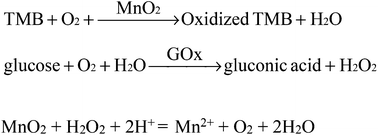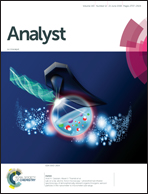An enzymatic reaction mediated glucose sensor activated by MnO2 nanosheets acting as an oxidant and catalyst†
Abstract
A self-regulated smart system would be highly desirable for analyte detection, in which a specific environment for detection could be self-modulated and the required reagents could also be in situ generated without further addition. Here, we have designed an intelligent glucose detection system composed of glucose, glucose oxidase (GOx), MnO2 and 3,3′,5,5′-tetramethylbenzidine (TMB), based on the enzymatic oxidation of glucose and dual roles of synthesized MnO2 nanosheets acting as both an oxidant and catalyst. Upon the addition of glucose/GOx, the MnO2 nanosheets partially decompose due to H2O2in situ generated via glucose oxidation. Following the addition of TMB, a typical color reaction occurs under slightly acidic conditions, thereby enabling the colorimetric determination of glucose. For this system, the specific conditions and the required reagents for glucose detection can be self-modulated and self-generated via the enzymatic oxidation of glucose to gluconic acid and H2O2, performing smart self-regulated functions. This is an outstanding advantage of our designed glucose sensing system. Moreover, the present sensing system responds to glucose quickly and sensitively with a detection limit of 100 nM, and is stable and specific toward glucose detection.



 Please wait while we load your content...
Please wait while we load your content...